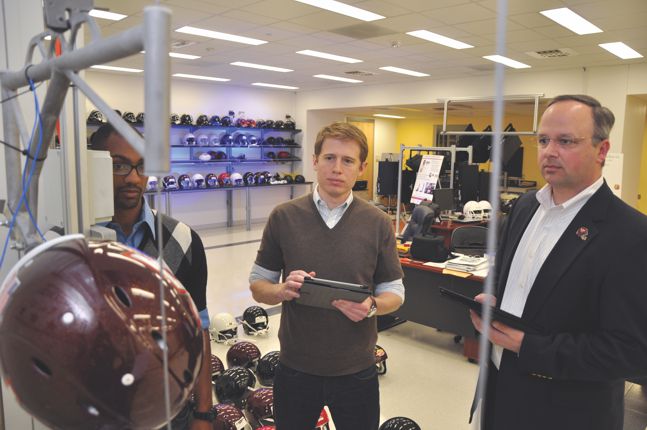Putting heads together for concussion research
DOI: 10.1063/PT.3.2209
The potential for long-term damage from concussions is nothing new, says University of Pennsylvania neuroscientist Douglas Smith. “We have known for a century that boxers get early dementia. I am extremely pleased that this has become recognized as a major public-health issue.”
The increased attention to concussions is due at least in part to high-profile lawsuits, such as one that led to a $765 million settlement that the National Football League reached in late summer with former football players who blamed head blows they’d taken in the game for depression, Alzheimer’s disease, and other ailments. Also contributing to that awareness is the increasing numbers of soldiers who survive war injuries because of improved gear but come home with head trauma. And surveys and autopsies of long-retired football players who suffered at least three concussions have raised concerns about the long-term effects of injury.
Football is notorious for concussions, but players of hockey, soccer, lacrosse, and other sports are also at risk. “And for kids, way above all these activities is bicycling. A lot of it is not wearing helmets,” says Stefan Duma, a Virginia Tech engineer who outfits off-the-shelf helmets with accelerometers and subjects them to blows. “The design of the shell and padding can be optimized.” For the same impact, a dummy head is subjected to 150 g in one helmet and only 75 g in another (g is Earth’s gravitational acceleration). The average concussion for adult athletes results from about 100 g, he says.

Helmet lab: From left, Ray Daniel, Steven Rowson, and Stefan Duma measure the effects of various applied linear and rotational forces on helmets and dummy heads.
Virginia Tech

Also known as mild traumatic brain injury, concussions cause blackout, nausea, disorientation, impaired memory and processing speed, motor-control issues, and other symptoms. Concussions occur when the head is subject to rapid rotational acceleration. The brain sloshes around in the skull “causing shear tensile and compressive forces,” Smith explains. “Axons are very vulnerable to rapid stretching. It’s a classic viscoelastic response, where the dynamic loading makes the axons behave stiffer and [be] more susceptible to damage.” And if axons—long neuronal projections that carry electrical signals to other neurons—rupture, the body cannot repair them. Rapid stretching can also trigger a chemical flood of sodium, he says. “It’s like throwing saltwater over live circuits. That’s why the lights go out. And if sodium is followed by calcium, which activates enzymes, the axons could be digested from the inside out.”
It’s hard to know how common concussions are, but Sports-Related Concussions in Youth: Improving the Science, Changing the Culture, a report released on 30 October by the National Academies, cites estimates for the US of up to 3.8 million sports- and recreation-related traumatic brain injuries, including concussions, per year. Given that many injuries go unreported, the actual number could be much higher, the report says.
Interdisciplinary research
Medical doctors, neuroscientists, physicists, engineers, and others are coming together to ask such questions as, When is it safe to return to play? What are the lasting implications of concussions? Who is most susceptible to long-term damage from concussions?
“Our first focus has been to assess structure after a concussion—the integrity of the white-matter fiber tracks in the brain,” says Annegret Dettwiler-Danspeckgruber, who studies head injuries at Princeton University. With diffusion tensor imaging (DTI)—a variation on magnetic resonance imaging (MRI)—scientists can look at the movement of water as a way to assess axonal injury (see also the story on page 20
Functional MRI (fMRI) can detect changes in blood oxygenation and blood flow that occur in response to activity in the brain. Naznin Virji-Babul of the University of British Columbia works mainly with kids and teens who have suffered concussions. “Using both fMRI and DTI, we can see changes in structure and function,” she says.
Virji-Babul also uses high-density electroencephalography. “EEGs are going to be good for diagnostics,” she says. “An MRI costs $500. EEGs have minimal cost, and you can see disruptions in the functional connectivity of the brain.” And researchers are beginning to use positron emission tomography to look at chemical and metabolic processes in the brain after concussion.
A major problem in concussion research, says Virji-Babul, “is that there is no way to say that a [given] person has never had a concussion.” The overall aims are to link genetics, brain injury, and recovery and to correlate changes in the brain with behavioral changes.
“Open the door to therapy”
So far, concussion studies tend to follow professional or college football or hockey teams for a sports season. Scientists conduct preseason baseline scans and neuropsychological tests, and then follow up after injuries. The dream of concussion researchers is to monitor the same players over much longer time scales.
In addition, research is expanding to youth, who don’t recover from concussions as well as adults. Among its other recommendations, the National Academies report encourages the establishment of a national system to keep track of sports-related concussions and calls for research on the consequences of single and repeated head impacts.
A key goal is to “nail down long-term neurodegenerative changes,” says Smith. “They seem to occur in about one-third of severe cases.” The ability to diagnose at the time of injury who will have long-term problems is “really exciting. That opens the door to therapy.”
More about the Authors
Toni Feder. tfeder@aip.org
